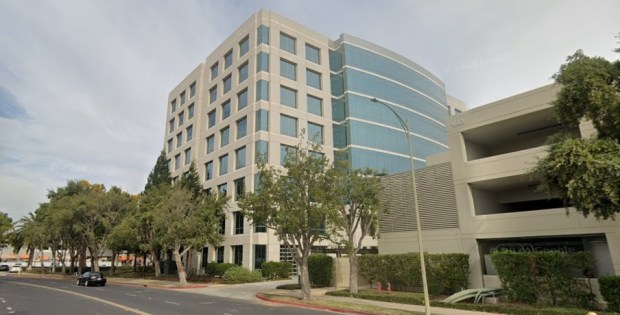There’s a couch, a keyboard and a washing machine. You can count two widescreen TVs, a dozen pieces of luggage and who knows how many bicycles. Don’t forget the three-story dollhouse. Or the pile of needles.
The collection rests on layers of tarps and clothes that likely adds up to hundreds, if not thousands, of pounds of debris, the remnants of an outdoor encampment on a one-acre plot in City Heights, a neighborhood in southern San Diego.
The homeless people who lived there are mostly gone. But the couple that owns the land, Shelly and Jason Stewart, just realized there’s a good chance they’ll have to pay for the clean up — and that they need permission from the state to do so.
“It’s just an impossible situation,” said Shelly Stewart.
The bureaucratic maze they’ve found themselves in is an outgrowth of a crisis that has steadily risen for two-and-a-half years. More than 1,000 people countywide lose a place to stay every month and the region’s shelter system has nowhere near enough space for everybody asking for help, and camping bans in multiple cities that have boosted penalties for sleeping outside.
When encampments are cleared, homeless people themselves often have the most to lose. One group in East County filed a lawsuit earlier this year alleging that all sorts of belongings were being illegally trashed, including personal documents needed to find jobs and housing.
Yet the literal tons of trash annually left by rivers and overpasses can also pollute waterways, to say nothing of the fire risk. Gov. Gavin Newsom issued an executive order over the summer telling agencies to clear encampments on state property, and the California Department of Transportation has increased sweeps in recent years. However, the directive didn’t come with any new funding and Caltrans officials previously declined to say what resources they’d need to dramatically expand cleanups.
A separate executive order might give San Diego leaders more flexibility to clear encampments on state land, although city spokesperson Matt Hoffman has said those details are still being negotiated.
The Stewarts’ property covers a lush hillside bordering interstates 15 and 805. Dense foliage makes it hard to see to the bottom of their land, so they weren’t even aware of the latest encampment until a few weeks ago. But neighbors living in condos next door have raised concerns since at least 2021.
Some homeless people have washed clothes in the complex’s hot tub, according to Rick Lozier, vice president of the local homeowners association. Fences were cut, he said, and packages began disappearing from doorsteps.
Public records show dozens of calls to police throughout that area in recent years.
Residents further submitted multiple requests for aid to Caltrans, which owns the land where nearby encampments were growing. Yet months’ worth of messages shared with The San Diego Union-Tribune show neighbors going back and forth with varying state officials without a clear resolution.
“It’s just a broken record of bureaucracy,” Lozier said.
Part of what could be slowing Caltrans’ response is an effort to give homeless people ample warning about coming cleanups, thereby minimizing the risk that somebody loses, say, an ID or birth certificate. “Caltrans coordinates with multiple agencies to address encampments and much of the timing is out of our hands,” a state official wrote in response to one complaint. “So it is difficult to provide an exact date and we try to avoid making promises that we may not be able to keep.”
Shelly Stewart first messaged Caltrans in 2023 about many of the same issues, including a damaged fence that allowed people to easily pass from state land onto her property.
Earlier this year, she nonetheless discovered close to a dozen people living at the bottom of her hill. The group included a girl who looked around four years old, Stewart said. One spot under a tree still has a child-sized basketball hoop and the picture book “I Love You, Little Bear.”
Stewart said she called the police, who successfully got everyone to leave. But who do you call about what was left behind? “I don’t even know who to get a quote from,” said Jason Stewart.
To make matters more complicated, the only way to bring in dump trucks and other machines that might be needed for a cleanup is by driving through Caltrans land. You need a permit to do that. And it costs $1,000.
“We are working with homeowner to get the encroachment permit needed so that she can bring a contractor through Caltrans right of way to do the cleaning,” agency spokesperson Aaron Hunter wrote in an email to The San Diego Union-Tribune. “When Caltrans comes in to clean the area that is state property the fence will be repaired.”
In addition, the city of San Diego may charge dumping fees.
A representative from Mayor Todd Gloria’s office visited the couple’s land Thursday. Shelly Stewart said officials have told her that some charges might be waived, and one floated the possibility of finding state funding to pay for the cleanup itself, but nothing is set in stone.
Earlier in the week, the couple escorted two reporters down the hill. Shelly Stewart gestured toward the hardened dirt. “This path was created by… ,” she paused. “Not us.”
At the bottom was a chain-link fence with an enormous hole. As the couple reached the opening, a man in a black T-shirt appeared on the Caltrans side and took several steps toward the fence.
“This is private property, my friend,” said Jason Stewart.
The man stopped. “I’m sorry my sister and brother,” he responded. Then he turned and walked away.
The couple continued on to “their” encampment. Some of the trees had been cut down. One looked blackened from fire. Shelly Stewart said they’d recently found a checkbook amid the junk, and when she tracked down the owner online he said the checks had been stolen out of a parked car.
Stewart felt conflicted about it all. She wasn’t looking to demonize people, and jail certainly didn’t seem to be the answer to homelessness. Neither did the status quo.
At one time, the couple dreamed of using the land to build multiple small houses that might offer families more affordable places to live. Now that idea seemed increasingly out of reach.
On the other side of the fence, the Stewarts came across a large yellow tent. Two siblings, a man and a woman, crouched inside. The man said he’d once lived on the Stewarts’ property but blamed the debris on others who’d moved in afterward. “I apologize,” he said. “I tell them to clean up their mess.”
“It’s gross,” the sister added.
“I’m sorry for you guys as well,” Shelly Stewart said. She told the pair that Caltrans might be coming soon to clear the area. Then Shelly asked if they needed anything.
“Can you help me get a job?” the man inquired. He was open to almost anything. The woman offered up a phone number where they could be reached.
Shelly wrote it down. “I’m not promising anything.”
“We appreciate it,” the woman said.
Note: Thank you for visiting our website! We strive to keep you informed with the latest updates based on expected timelines, although please note that we are not affiliated with any official bodies. Our team is committed to ensuring accuracy and transparency in our reporting, verifying all information before publication. We aim to bring you reliable news, and if you have any questions or concerns about our content, feel free to reach out to us via email. We appreciate your trust and support!



